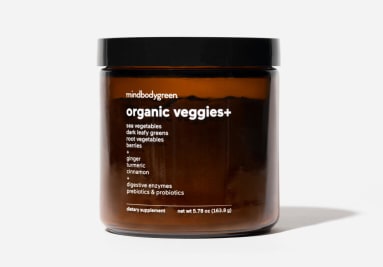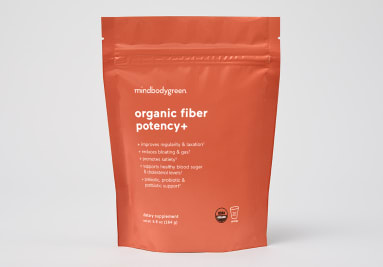10 Wise Nutrition Rituals This Nutrition PhD Learned From Her Single Mother


You know how some people actually love their jobs? My mom tells me that’s exactly how she felt about being a mother (the hardest and most important job she’s had to date).
Pouring herself into motherhood and working at it like a boss lady, she was (and still is) simply a stellar mom. My dear mother poured herself into her two children sacrificially and with full-on energy. As a single mother with limited resources, she (and other parents and guardians like her) are to be commended.
My mom’s outpouring of love included caring about every facet of my health, and nutrition was at the forefront. By the time I was a young child, eating healthfully (and engaging in regular physical activity) were simply part of my daily ritual and vocabulary. A healthy lifestyle was totally innate and not something I thought about. It was my normal.
My wise mother graciously set me up for a trajectory of well-being in adulthood, and ultimately, I chose a career in the health and wellness sector. Originally on a pre-med track in college at Penn, I pivoted into nutrition science after taking a class that blew my mind–where I first learned about the critical preventive health and wellness potential (and personalized approach) of nutrition.
Before my college years, I’m embarrassed to say that I had a few sarcastic teenage moments where I was known to utter the words “oh, wise sage” in my mother’s direction when she shared advice. I think she’s been giving me advice before I exited her womb, but nonetheless, my teenage self found her guidance to be comical at times. The joke was on me, because ironically, she actually was a wise sage dispensing incredibly prudent advice.
This wisdom naturally extended into her food and nutrition choices and the wellness lifestyle she created in our home. Now as a grown woman and career nutrition scientist and dietitian, I remember and savor these brilliant nutrition principles that my mom instilled in me. I want to share them with the world, in case my mother’s wisdom can help inspire health and wellness in caregivers pouring themselves into our next generation.
Here are 10 key areas of nutrition wisdom my mother poured into me.
Prioritize gathering & connection
Eating food at tables with people you love seems pretty basic, but it’s become seriously underrated these days. Let’s bring gathering at tables back (and put the devices down).
Part of the daily ritual my mom set up in our earliest years was gathering around tables with intention, whether it was a bar in the kitchen for breakfast or the dining room table for supper. Or maybe it was popcorn in the living room while we watched Friday evening TGIF shows together. Regardless, we were coming together and investing time in each other over delectable food.
Tables and coming together over food ensured daily connection. This engagement was critical in childhood and adolescence. Allowing us to feel seen and heard, and instilling essential life lessons via teachable moments into our hearts and minds, these countless daily conversations were invaluable.
Eating together regularly involves routine. Whether you call it routine (or the sexier term “ritual” these days), my mom, a former elementary school teacher, was skilled at creating order. As her beloved child, I found calm in the anticipation of a healthy routine, and reward in the discipline it involved.
She even had an amazing sticker chart system that started in toddlerhood, where my brother and I earned stickers (and pride) for completing little chores and other tiny wins, including these earliest disciplines of simply enjoying our meals at the table with respect for others at that table.
Gratitude is essential
My maternal grandparents grew up during the Great Depression. As parents, their daily posture of gratitude for the smallest things clearly impacted my mother. In lieu of criticism and focusing on discouraging things, my mom encouraged us from a young age to think of and share things we were grateful for.
Food and its nourishment for our bodies sat atop that daily list of gratitude. She explained that many others in the world, including children, did not have the guarantee of food. Meanwhile, our refrigerator and pantry had more than enough, and our tummies were full.
A prayer preceded each of our meals, where we expressed thanks for the food on our table, the health of our bodies, and our many other blessings in life.
Protein and veggies rule
Before the Atkins diet and keto lifestyles were in vogue, my mom had already demoted carbs in our home. She did this by elevating protein and vegetables on our plate. The actual “mom rule” was this: “Please eat all of your protein and vegetables. The carbs and fruit are optional.” She was not our sous-chef, altering mealtime to our every juvenile whim. We had guidelines and were allowed to exert independence within those smart boundaries.
We were omnivores, and I still am. Protein was typically fish, poultry, eggs, pork, shellfish, and occasionally beef. Processed meats like a hot dog or salami were a rare treat.
In any given month, our vegetable array felt like it included the whole rainbow of colorful veggies (literally, I think she exposed us to every vegetable that grandad’s garden, the grocery store, and nearby farmer’s markets offered), whether leafy greens, root vegetables, legumes, and more.
Fruit was thought of as dessert. Our taste buds (which are malleable and thus, trainable) still found the natural sweetness of fruits (berries have always been my favorite) to be delightfully satisfying.
And when my mom said “carbs” were optional, she meant traditional carbohydrates like bread, pasta, rice, and the like. In an era of oh-so-white (and processed) Wonder Bread in the 1980’s and 90’s that I grew up in, my mom went against the grain quite literally. For our meals, she worked hard to source truly 100% whole wheat bread and pastas, along with wild rice and perhaps my favorite, stone-ground grits (yes, I’m a Southern gal). In fact, my mom was turning food over and reading nutrition labels (and teaching me to do the same) way before that was a thing.
Those vegetables, fruits, and healthy carbs meant lots of gut-critical fibers in our daily diet. My mom was caring for my gut microbiome long before it was “cool”.
My mom ignored the low-fat fad of the era. The fats in our meals were neither demonized nor celebrated, they were just there. Whether extra-virgin olive oil, butter, or fish rich in omega-3s, a diverse array of healthy fats were in the mix.
Hydration was of utmost importance too. Water and cow’s milk were our main beverages, with the occasional and small serving of 100% OJ (with the pulp fiber) or 100% cranberry juice gracing our meals from time to time.
Food is fuel (so stay active)
I remember my mom discussing food as fuel at a very young age. Fuel to energize our activities and fuel for our brain.
Ballet became a passion of mine at a very early age, and my mother would always ensure that I had adequate food fuel (a healthy snack often involving bran, peanut butter, and fruit) and hydration (full water bottle) before each practice. The same was true in my later years playing various competitive sports.
Interestingly, thinking about food as fuel presupposes that you’re burning said fuel–i.e., expending energy through physical activity. Here's a sad fact: Kids used to play (and move) a lot more before the digital era eroded such critical health practices. I'm glad we were always on the move growing up. When dinner was ready, it was extremely common for my mom to ask me to pause my ballet routine mid-jump or mid-pirouette (I was always practicing in the living room) and then round up my brother from shooting basketball hoops outside.
Viewing meals as high-quality energy inputs also helped set me up for a healthy relationship with food. Using food as a coping mechanism was something I only saw on the occasional TV show, and using food for control (e.g., restricting consumption) was something I saw some girls do in high school. Thankfully, those were both unnatural food approaches for me because of my mom’s wisdom.
Because food is fuel, breakfast was a non-negotiable from breastfeeding years on up. Oats, whether steel cut or plain Cheerios, were common, as were grits and eggs. My mom would naturally sweeten our oatmeal with milk and fruit (either banana slices or berries) and complemented it with cinnamon. Years later, I recall being one of the few college students in the dining hall every morning for breakfast. Before “nootropics” was a mainstream term, I simply knew that I needed my “brain food” before class, because it was a prudent habit ingrained in me by my mother.
Optimal (not adequate) nutrition drives health
For hundreds of years, nutrition and the nutrients foods provide have been viewed by the majority of medical professionals, researchers, and consumers as preventing deficiencies. And while it’s been awhile since sailors on long voyages needed limes to prevent scurvy, the modern healthcare approach sadly hasn’t evolved much on the nutrition front.
Only quite recently has the nutrition discussion (thankfully) pivoted to not just avoiding gross deficits, but being “functional” and promoting diverse aspects of whole-body health by optimizing nutritional sufficiencies. My mom was ahead of the curve, because this functional nutrition optimization philosophy was how she lived and thus, how we operated.
My mother was not interested in her children barely scooting by on their daily nutritional needs or guessing whether we were nutritionally adequate. As in our schoolwork, she set us up and inspired us to aim for the “A” range when it came to our nutrition.
I remember my mom being cognizant of minding our nutrient gaps before blogs and social media even existed to bring such issues mainstream. There were many examples, but I will recall a few:
- Supplements: My mom incorporated a targeted, daily boost of calcium and vitamin D3 into my childhood and adolescence via high-quality supplementation, when my calcium needs were the highest (1,300 mg per day) of my entire life, and when my bone density was rapidly accruing and setting up my bone health trajectory for the rest of my life.
- Gut essentials: The baseline diet my mom provided us was fiber laden, but wheat bran and prunes made an appearance from time to time to further help with healthy bowel movements and staying regular. Probiotics from yogurt were in the mix, too.
- Performance nutrition: After school, my mom would bring water jugs and healthy protein-carb combination snacks she whipped up, so my brother and I didn’t crash in sports practices or other extracurriculars.
- Personalized nutrition: I remember my mom telling me about an essential mineral known as iron that was found in the protein on my plate (especially the eggs and meats, she was referring to the most bioavailable heme iron that I would later learn about in detail in college), and how iron is important for everyone but especially because I was a menstruating female experiencing monthly blood loss.
Perhaps it’s no surprise that I pursued a PhD in nutrition, and no surprise that my personal nutrition philosophy for myself and clients is one that optimizes nutrition and is sensitive to personalized needs. And that I get the ridiculously fun job of innovating and creating high-quality nutritional products that help people live healthier lives on the daily!
Plants should be plentiful
While terms like “plant-based” are hot right now and confuse carnivores into thinking they must convert to strictly vegetarian or vegan lifestyles (nothing wrong with that, by the way), my upbringing incorporated some animal protein daily, but was also heavily plant-based, too. Animals and plants are not contradictory concepts.
Indeed, the colorful plate and dietary pattern full of plants (whole grains, fruits, vegetables, legumes, nuts, seeds) that my mom filled our home with meant that my growing body was full of fiber, complex carbohydrates (great for blood sugar balance and cardiometabolic health, by the way) and a diverse lineup of micronutrients and phytonutrients.
Support local farmers
I don’t recall carbon footprints being discussed much in school, nor was it a topic at our dinner table (recycling was, however), but I do remember my mom being very intentional about supporting local foods (and farmers) when they were available.
Whether it was fish my grandfather caught in Charleston on a Saturday morning, or the cornucopia of beautiful vegetables he grew, or supporting local offerings from Piggly Wiggly (FYI, that’s a grocery store for those of you who are less familiar with the South) or Rosebank Farms on the way out to the beach, my mom loved keeping her “foraging” close to home.
Be intuitive (listen to your body)
Outside of certain academic circles, intuitive and mindful eating were not topics discussed until quite recently. Now these concepts are mainstream, and we’re better for it. When we take care of our bodies, they are brilliant and resilient. They send us signals all the time, whether we are hungry, thirsty, full, stressed, or sleepy. Just to name a few.
My mom encouraged us to eat slowly enough as children so we could, in fact, hear our bodies’ cues. Part of that was also the fact that we were conversing (back to those gathering and connection concepts) and had to put down the utensils from time to time.
Fast forward to my adults years, and I find myself rushing mealtime at times. Similar to inhalation, too many of us adults speed through meal time, failing to savor or find joy in food. While our stomach and brain (hello, gut-brain axis) are attempting to huddle and communicate with us, we’ve already finished eating and have moved onto sloshing back some water and coffee to keep on keeping on. Whenever possible (and I'm totally preaching to myself here), let's slow down and savor our food.
Another intuitive eating principle my mother espoused (unknowingly) was the fact that we did not operate in a “clean plate club” world. Well, aside from the protein and veggies we were expected to consume. Outside of those basic guidelines, the rest was optional (and options encourage autonomy and empower children) and involved us intuitively listening to hunger and satiety signals our bodies provided.
Celebrate: Food is fun!
While food and mealtime are something I’ve enjoyed my entire life, there were also next-level fun food experiences my mom introduced. These oftentimes aligned with celebrations and gatherings of family and friends.
Eating out was rare and thus, special. Mind you, portions weren’t quite as ridiculous as they are today, and for the most part, my mom ensured that the same principles for healthful eating at home applied at restaurants.
Traditional desserts (think: cake, cupcakes, pie, cookies, donuts) were also a very rare treat we experienced outside of the home. My mom chose to not have sugar- and calorie-laden (which are energy dense and not nutrient dense) desserts in the house. While my mom could bake a mean casserole, she simply was not whipping up cookies, cakes, and pies.
My dear maternal grandmother was a talented cook and baker. I fondly recall the special treat of a fruit-laden or nutty pie for a few holiday gatherings each year. Of course, there was my birthday: carrot cake with cream cheese icing in the shape of a roller blade (I had birthday parties at the local roller rink most years).
And then there was the sheer joy and surprise that my mom wove into certain holidays with genuine creativity and artistry. On Valentine’s Day growing up, I remember she would make buckwheat pancakes (yes, buckwheat) in the shape of hearts. She colored them pink naturally with beet juice, with some drizzled maple syrup to top them off. As I said, food is fun.
Be exclusive
While my mother was inclusive when it came to fruit and vegetable variety, she also excluded certain food and beverage items with intention. Exclusivity is important sometimes. “Out of sight, out of mind” is such a true statement. What my mother chose to exclude from our home, refrigerator, and pantry–were out of our minds (and bodies).
Calorie-excessive, nutritionally-devoid, processed food options with added sugars, hydrogenated fats, and long ingredient lists simply weren’t around. I’m talking about chips, soda, cookies, other baked goods, sugary cereals, etc. True story: I discovered the modern inventions known as Cheez Whiz and colorful circles known as Fruit Loops at a friend’s house well into elementary school.
My first soda was consumed at a middle school dance, and I almost immediately regretted the decision while attempting to divert carbonated burps away from my schoolmate’s face during an awkward slow dance to some Boys II Men ballad. (As an aside, I’m not sure why my prepubertal self was dancing to “I’ll Make Love To You” in middle school, but that’s a topic for another day.)
Thank you, mom
While I had a genuine appreciation and love for my mother growing up, my awe and gratitude have deepened in adulthood. I’m now living the fruits of my mother’s labor, and that includes the innovative nutrition wisdom and ritual she infused into our home.
Like a mindbodygreen “OG”, my mom was prioritizing my mind, body, soul, and environment before that was even the “in” thing to do. My brother and I are better for it. To my truly sage mother (who could probably be an honorary dietitian), I thank you and love you. Happy Mother’s Day to you, and to all of the truly phenomenal mothers we honor today (and every day).

Ashley Jordan Ferira, Ph.D., RDN is Vice President of Scientific Affairs at mindbodygreen. Ashley received her B.A. in Biological Basis of Behavior from the University of Pennsylvania (along with a double minor in Nutrition and Music) and Ph.D. in Foods and Nutrition from the University of Georgia. Her research contributions span vitamin D, cardiometabolic health, bone density, and weight management. Ferira is a nutrition scientist and dietitian with experience in nutrition product innovation and development, scientific affairs, education, communications, and SEO writing for global firms, including Nature Made, Metagenics, Three Ships, and mindbodygreen.
In addition to her mindbodygreen contributions, Ferira is published in Health, Metagenics Institute, American Family Physician, The Journal of Clinical Endocrinology & Metabolism, and Osteoporosis International. She has a passion for the translation of evidence-based science into innovative and high-quality products and information that help people lead healthier lives. She is a believer in compassionate, informed, and personalized approaches to nutrition, health care, and wellness. Ashley lives in beautiful Charleston, South Carolina, where she was born and raised. Whether savoring an orchestral performance or delectable meal at a local restaurant, you will find her enjoying Charleston’s cultural and culinary arts with family and friends.


